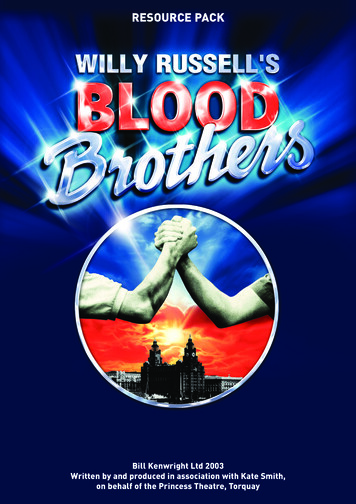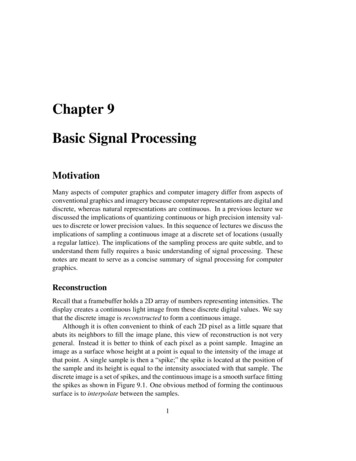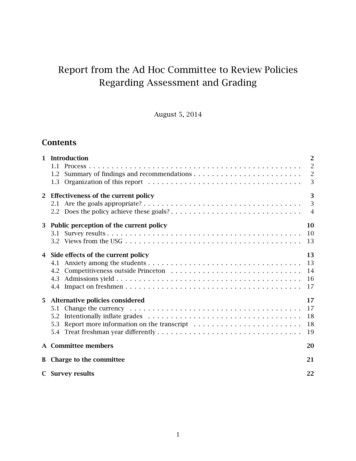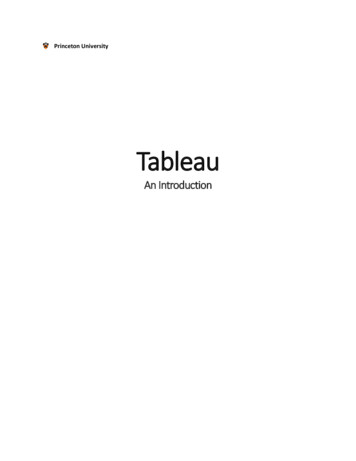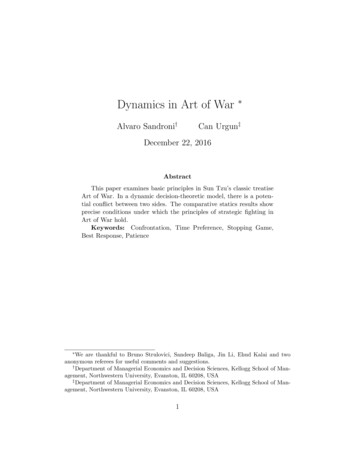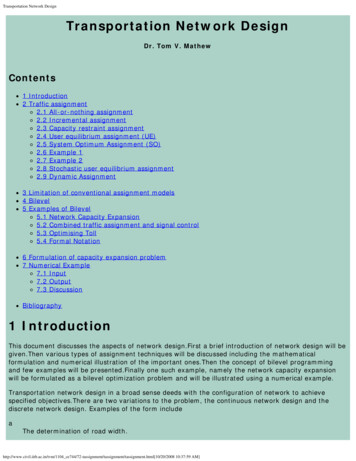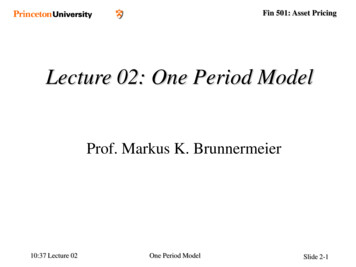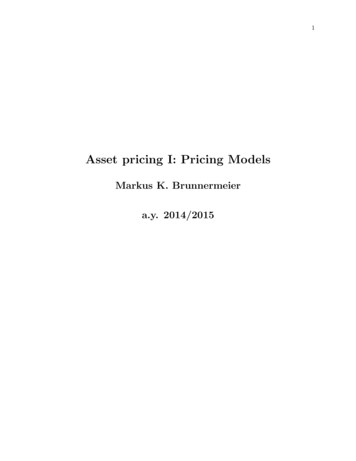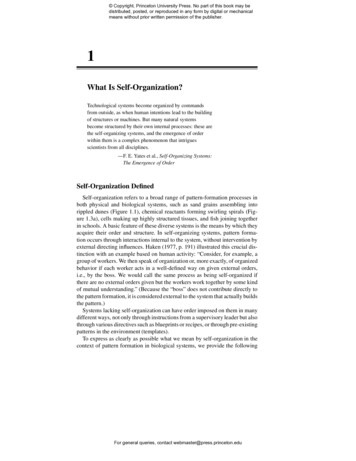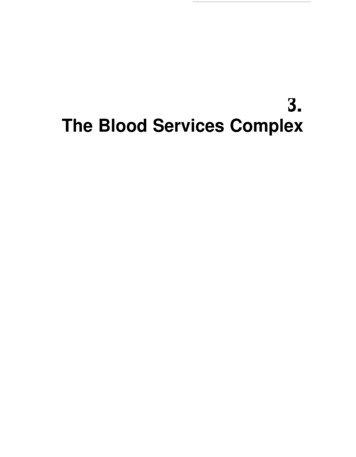
Transcription
The Blood Services Complex
ContentsPagePart 1: The Voluntary, Whole Blood, and Blood Components Sector. . . . . . . . . . 51Introduction . . . . . . . . . . . . . . . . . . . . . . . . . . . . . . . . . . . . . . . . . . . . . . . . . . . . . . . . . . 51Blood Collecting Organizations . . . . . . . . . . . . . . . . . . . . . . . . . . . . . . . . . . . . . . . . . 52Blood Collections in the Voluntary Sector . . . . . . . . . . . . . . . . . . . . . . . . . . . . . . . . 57Costs of Blood and Blood Components . . . . . . . . . . . . . . . . . . . . . . . . . . . . . . . . . . 59Costs and Charges for Blood Products. . . . . . . . . . . . . . . . . . . . . . . . . . . . . . . . . . . 59Access . . . . . . . . . . . . . . . . . . . . . . . . . . . . . . . . . . . . . . . . . . . . . . . . . . . . . . . . . . . . . . . 60Part2: The Commercial Plasma and Plasma Derivatives Sector . . . . . . . . . . . . . 63Overview . . . . . . . . . . . . . . . . . . . . . . . . . . . . . . . . . . . . . . . . . . . . . . . . . . . . . . . . . . . . 63,Sources of Raw Plasma . . . . . . . . . . . . . . . . . . . . . . . . . . . . . . . . . . . . . . . . . . . . . . . . 65Finished Products Licensed for Use in the United States . . . . . . . . . . . . . . . . . . . . 67Conclusion . . . . . . . . . . . . . . . . . . . . . . . . . . . . . . . . . . . . . . . . . . . . . . . . . . . . . . . . . . . . . 73LIST OF TABLESTable No.Page10. Whole Blood Collections by Type of Facility and Affiliation, 1980. . . . . . . . 5211. Activities of Three Major Voluntary Blood Service Organizations . . . . . . . . . 5312. American Blood Commission Member Organizations and Its Board ofDirectors, April 1984. . . . . . . . . . . . . . . . . . . . . . . . . . . . . . . . . . . . . . . . . . . . . . . . 5613. American Blood Commission Statements of Support, Revenue, andExpenses and Changes in Fund Balances for Years Ended Mar. 31,1976-83 (thousands of dollars) . . . . . . . . . . . . . . . . . . . . . . . . . . . . . . . . . . . . . . . . . 5714. Blood Center Processing Fees for Blood and Components (1983) . . . . . . . . . . . 6015. American Red Cross Blood Services Statements of Revenue and Expensesand Statement of Assets and Liabilities, 1980-83 (or the year ended June 30)(in thousands) . . . . . . . . . . . . . . . . . . . . . . . . . . . . . . . . . . . . . . . . . . . . . . . . . . . . . . . 6116. Blood Center Costs and Hospital Charges for Red Cells, 1980. . . . . . . . . . . . . 6217. Changes in Processing Fees for Red Cells Compared to Changes in TotalU.S. Health Care Expenditures . . . . . . . . . . . . . . . . . . . . . . . . . . . . . . . . . . . . . . . . 6218. Number of Plasma Centers Located in the United States (by owner,fractionator, multi-operator single operator, and nonprofit) . . . . . . . . . . . . . . 6319. Production and Consumption of Human Serum Albumin andAntihemophilic Factor. . . . . . . . . . . . . . . . . . . . . . . . . . . . . . . . . . . . . . . . . . . . . . . . 6520. Albumin and Plasma Protein Fraction Consumption unselectedCountries, 1976. . . . . . . . . . . . . . . . . . . . . . . . . . . . . . . . . . . . . . . . . . . . . . . . . . . . . . 6521. Principal Producers of Human Plasma Derivatives for the U.S. Market . . . . . 6622. Manufacturers of Normal Serum Albumin (NSA) and Plasma ProteinFraction (PPF) Licensed for Use in the United States . . . . . . . . . . . . . . . . . . . . . 6723. Manufacturers of Coagulation Factors Licensed for Use in theUnited States . . . . . . . . . . . . . . . . . . . . . . . . . . . . . . . . . . . . . . . . . . . . . . . . . . . . . . . . 6924. Manufacturers of Selected Immune Globulins for Use in the United States . . 7125. Representative Blood Center Prices for Plasma Derivatives. . . . . . . . . . . . . . . . 73LIST OF FIGURESFigure No.Page4. Relationships Among Blood Collecting Facilities, 1980 . . . . . . . . . . . . . . . . . . . . 525. Increases in Red Cells Available for Transfusion As a Result of ImprovedInventory Management and Decreased Outdating . . . . . . . . . . . . . . . . . . . . . . . . 586. Recent Trends in Whole Blood and Components Distributed forTransfusion( Red Cross data only) . . . . . . . . . . . . . . . . . . . . . . . . . . . . . . . . . . . . . 587. U.S. Production of Factor VIII (inactivity units) and of Albumin/PPF(in 12.5 Gram Equivalents), 1971-82 . . . . . . . . . . . . . . . . . . . . . . . . . . . . . . . . . . . 648. Flow of the Nation’s Blood Resources, 1980. . . . . . . . . . . . . . . . . . . . . . . . . . . 74
3.The Blood Services ComplexPART 1: THE VOLUNTARY, WHOLE BLOOD, ANDBLOOD COMPONENTS SECTORIntroductionThe whole blood sector is called “voluntary”because it collects blood primarily from unpaiddonors. In 1980, only 2.2 percent of the 11,880,000units of whole blood collected was collected frompaid donors (518), in contrast to the situation of10 years ago when over 10 percent of whole bloodwas collected commercially. Three types of facilities are involved in the voluntary sector: 1)community and regional blood centers whichcollect and distribute blood to hospitals in circumscribed geographic areas; 2) hospital bloodbanks which both collect and transfuse wholeblood and components; and 3) hospitals whichprimarily store and transfuse blood, but do notcollect it. In addition, the voluntary sector depends on the commercial pharmaceutical firms tofractionate its recovered and salvaged plasma.Community or regional blood centers generallyprovide a full range of blood services to a surrounding geographic area. These services may include collection, testing, and labeling of blood,and distribution of blood and blood products tohospitals, physicians, and hemophilia care centers. In addition, blood centers often conduct research and training programs.Hospital blood banks generally provide asmaller range of services than regional bloodcenters, usually limited to the collection and storage of whole blood and components. Some common laboratory tests may be available in-house,depending on the size and scope of the blood bankoperations, while other tests must be sent out toprivate laboratories or the regional blood center.Often hospital blood banks orient donor recruitment efforts to the friends and relatives of patients; thus, many of the existing nonreplacementfee programs are associated with hospital bloodbanks.The third type of facility involved in the voluntary sector is the hospital transfusion service,which is responsible for the administration ofblood and blood components within the hospital. Some hospitals do not collect any blood butobtain their blood and blood products throughan outside supplier, either a regional blood center or another hospital blood bank, thus makingthe transfusion service the primary participant inblood management and use in such noncollectinghospitals. While transfusion services also serve asblood banks, they are called transfusion servicesto differentiate them from blood banks which collect, as well as store, blood.Although blood collection began in hospitalblood banks, over time they have come to playless of a role in blood collection. In 1971, 69 percent of the blood collected came from regional andcommunity blood centers (555). By 1980, regionaland community blood centers collected 88 percent of the total, and comparable, though lessreliable figures for 1981 indicate that 91 percentof total whole blood collections were made throughblood centers (29). Surgenor & Schnitzer/ABC(518) attribute the predominance of regionalcenters to the centers’ ability to collect bloodthrough constant mobile collections. In 1980, 69.5percent of whole blood collections was throughmobile units. There is some speculation that thedominance of regional blood centers may bereversed in the future as hospitals seek to gain control over costs in the face of such cost containment measures as the prospective payment system—although, as discussed below, there arethose who argue that cost containment may accelerate the trend toward more centralized collections(see ch. 5, pt. 3).51
52 . Blood Policy and TechnologyTable 10.—Whole Blood Collections by Type ofFacility and Affiliation, 1980Blood Collecting OrganizationsAs shown in figure 4 and table 10, blood collection and transfusion facilities in the voluntarysector are represented by three organizations withoverlapping memberships: the American RedCross (ARC), the American Association of BloodBanks (AABB), and the Council of CommunityBlood Centers (CCBC). The American Red Crosshas 57 regional centers operating under a singleFederal license, and also maintains an affiliationwith the New York Blood Center (which is a member of CCBC). The Red Cross regional centerscover about half the geographic area of the UnitedStates, and collect about half the Nation’s wholeblood.Another 45 percent of the Nation’s whole bloodis collected by institutional members of the AmerFigure 4.—Relationships Among Blood CollectingL1\Otherfig. 8).(41Number offacilitiesRegional and communityblood centers:AABB only . . . . . . . . . . . . . .CCBC . . . . . . . . . . . . . . . . . .ARC . . . . . . . . . . . . . . . . . . . .Unaffiliated. . . . . . . . . . . . . .Total for blood centersHospitals:AABB affiliated . . . . . . . . . .Unaffiliated. . . . . . . . . . . . . .Total for hospitalsOther collections. . . . . . . . . . 0,03816,6376,432Total—U.S, collectionsEuroblood imported . . . . . . . .10,880,079265,839Grand total11,145,918ican Association of Blood Banks, including members who belong to CCBC. In 1980, seven ARCregional centers and all but two Council of Community Blood Centers belonged to AABB, as did1,977 blood collecting hospitals. There were 101community blood centers that were membersonly of AABB. Approximately 2 percent of bloodcollections were through 16 unaffiliated bloodcenters.facilities)57ARC regionsIIThe AABB was formed in 1947 to protect theinterests of already existing hospital blood banksin the face of a plan announced by the Red Crossto attempt to collect and organize the Nation’s entire blood supply (307). Existing hospital and regional blood banks wanted to maintain theirestablished collection programs. Today, theAABB represents over 2,OOO institutional (voting)members, as well as about 7,OOO individual members, primarily blood bank personnel (e.g., administrators, medical technologists). Institutionalmembers include blood centers, hospital bloodbanks, and transfusion services. While bloodcenters account for two-thirds of the blood collected by AABB members (29), each institutionalmember has a single vote regardless of its size.In 1962, the Council of Community BloodCenters was formed by six community blood bankadministrators who were dissatisfied with thedominance of the AABB by hospital blood banks.
Ch. 3—The Blood Services Complex 53CCBC today consists of 27 institutional members,i.e., community or regional blood centers. All buttwo current CCBC members (New York BloodCenter and Puget Sound Blood Center in Seattle) are also members of AABB. CCBC as an organization has played a relatively minor role in thepolitics of whole blood delivery, which has beendominated by ARC and AABB. CCBC’S recentmove to the Washington, DC, area, where theRed Cross, the AABB, and the American BloodCommission are headquartered, was a move designed in part to make CCBC more of an activeparticipant in National Blood Policy deliberations.Thus, three major organizations representalmost all the blood collection organizations inthe United States. Although there is some overlapin organizational membership and in function, thethree major organizations espouse different philosophies and are designed to serve different functions (see table 11). The AABB and CCBC areorganizations which represent individual bloodcollection facilities. The Red Cross, as a corporation and a blood collector in its own right, provides a Federal license to collect and process bloodas well as an organizational framework to itsmember centers, although each center operatessomewhat independently and is required to bemore or less self-sufficient. “AmericanRed Cross (ARC) Blood ServicesRed Cross chapters choose whether or not toengage in blood services and other services offeredby the Red Cross, except disaster services andservices to the Armed Forces, which are requiredto be available from all chapters. In 1982, 1,873of the 3,01.1 Red Cross chapters participated in57 ARC regional blood services. Donor recruitment, blood collection, and processing are performed by volunteers and staff of the regionalcenters. In addition to blood collection, regionalcenters also provide diagnostic and other bloodrelated services. National headquarters providesstandards for its 57 regional blood centers and inspects them periodically. Interregional resourcesharing is accomplished by the use of a computerized inventory system. ARC national alsomaintains a Rare Donor Registry, and many ofits regions conduct research (so).Table Il.—Activities of Three Major Voluntary Blood Service OrganizationsActual blood services:Number of institutional members . . . . . . . . . . . . . . . . . . . . . . . . . . . . . . . . . . . . . .Units of blood collected by organization or members in 1981a. . . . . . . . . . . . .Actual blood collection. . . . . . . . . . . . . . . . . . . . . . . . . . . . . . . . . . . . . . . . . . . . . . .Formal resource sharing program. . . . . . . . . . . . . . . . . . . . . . . . . . . . . . . . . . . . . .Other activities or characteristics:Management conferences . . . . . . . . . . . . . . . . . . . . . . . . . . . . . . . . . . . . . . . . . . . .Government liaison . . . . . . . . . . . . . . . . . . . . . . . . . . . . . . . . . . . . . . . . . . . . . . . . . .Organ and tissue procurement . . . . . . . . . . . . . . . . . . . . . . . . . . . . . . . . . . . . . . . .Scientific programs . . . . . . . . . . . . . . . . . . . . . . . . . . . . . . . . . . . . . . . . . . . . . . . . . .Scientific and educational publications. . . . . . . . . . . . . . . . . . . . . . . . . . . . . . . . .Rare donor registry . . . . . . . . . . . . . . . . . . . . . . . . . . . . . . . . . . . . . . . . . . . . . . . . . .Blood bank procedures manual. . . . . . . . . . . . . . . . . . . . . . . . . . . . . . . . . . . . . . . .Standards published . . . . . . . . . . . . . . . . . . . . . . . . . . . . . . . . . . . . . . . . . . . . . . . .Institutional inspection and accreditation . . . . . . . . . . . . . . . . . . . . . . . . . . . . . . .Training for technologies . . . . . . . . . . . . . . . . . . . . . . . . . . . . . . . . . . . . . . . . . . . . .Incorporation as single entity . . . . . . . . . . . . . . . . . . . . . . . . . . . . . . . . . . . . . . . . .Plasma products marketed . . . . . . . . . . . . . . . . . . . . . . . . . . . . . . . . . . . . . . . . . . .Formal ongoing strategic planning activity. . . . . . . . . . . . . . . . . . . . . . . . . . . . . . Collected by members.“ “Several members of these organizations are engaged in organ and tissue procurement.ards of care.SOURCE: Office of Technology Assessment.ARCAABBCCBC57 regions1,873 chapters5,799,024xx2,176273,395,854 b2,320,750 C xxxxxxxxxxxxxxxx *xxxxxxxxx *
54 . Blood Policy and TechnologyRed Cross Blood Services also maintains aplasma products division operating out of its national headquarters, which is responsible for arranging contracts for fractionation of plasma fromRed Cross blood collections and marketing of theproducts on a competitive basis with the commercial fractionation industry (see below). The RedCross recently entered into an agreement withBaxter-Travenol which would give it more control over fractionation of the plasma it collects(and the ability to develop new products), but RedCross does not fractionate its own plasma. In general, 85 percent of the plasma products sold bythe Red Cross (primarily albumin and Factor VIII)is marketed by and within Red Cross regions; andthe remaining 15 percent is marketed outside theregions (486). Eleven Red Cross regions are alsolicensed as source plasma centers.Other fairly new activities of the Red Cross include efforts at strategic planning and management, and involvement in organ and tissue procurement (see ch. 7, pt. 2). In the last year, RedCross Blood Services has created a Planning, Marketing, and Operations Research Division at National Headquarters. Blood services is one concern of an organization-wide planning groupcalled the President’s Council. The Red Cross isconcerned that particularly because of technological advances such as genetic engineering, bloodservices as it exists today may be a declining industry. Currently, Blood Services accounts foralmost 60 percent of the Red Cross’s gross revenues (see “Costs and Charges for Blood Products” for further discussion of Red Cross BloodServices finances).The entire ARC organization holds a specialposition in the national blood services complex.ARC is the only one of the blood service organizations with a congressional charter, although thecharter is for disaster relief, not blood collections.(The charter is dated 1905, and Red Cross bloodcollections were not begun until the 1940s. ) ThePresident of the United States is ARC’s honorarychair, and other cabinet members serve as honorary counselor and treasurer. The President appoints eight of the ARC’s Board of Governors,and by an act of Congress ARC audit reports arereviewed by the Department of Defense. For thesereasons, ARC is sometimes described as a quasigovernmental agency.American Associationof Blood Banks (AABB)The American Association of Blood Banks characterizes itself as the only organization devotedexclusively to blood banking and blood transfusion services (28). As a scientific and administrative association, AABB sets technical standardswhich are followed by its members (see, e.g., 583),inspects and certifies the operations of its institutional members, and serves as a liaison with theFederal Government and with the other blood collection organizations. A major part of AABB’soperation is its National and Regional Clearinghouse (see “Coordination of Blood Resources”in ch. 5), which accounted for two-thirds of itsassets at the end of 1982 ( 1.3 million of AABB’s 2 million total) (20).The basic standards in blood banking were firstformalized and published by the AABB. The RedCross and AABB have agreed to keep their standards essentially identical and even jointly publishthe “Circular of Information” which must be included with shipments of blood components asrequired by the Food and Drug Administration(FDA). The AABB also initiated the first formalnongovernment inspection and accreditation system. All institutional members of AABB are inspected on a regular basis and are dropped frommembership if they are not in compliance. AABBalso conducts inspections of approved schools fortraining specialists in blood banking to ensure thatthe required educational standards are maintained.Council of Community Blood Centers (CCBC)The primary audience for CCBC activities isblood center managers. (The AABB has recentlybecome more actively concerned about blood center administration; to date, the AABB has orienteditself primarily to hospital blood banks and to theday-to-day technological aspects of blood services. ) CCBC describes itself as serving as a forumfor blood center administrators, medical directorsand senior management. It publishes no technical or procedures manuals, and does not operate
Ch. 3—The Blood Services Complex 55a formal resource exchange system, but holds twomeetings a year to discuss management issues.CCBC is a relatively small organization which hasstruggled financially in the past. It derived almostall of its 207,000 income in 1983 from membership dues (136).discussion of blood policy issues. ABC has established stan
CCBC as an orga-nization has played a relatively minor role in the politics of whole blood delivery, which has been dominated by ARC and AABB. CCBC’S recent move to the Washington, DC, area, where the Red Cross, the AABB, and the American Blood Commission are headquartered, was a move de-signe
